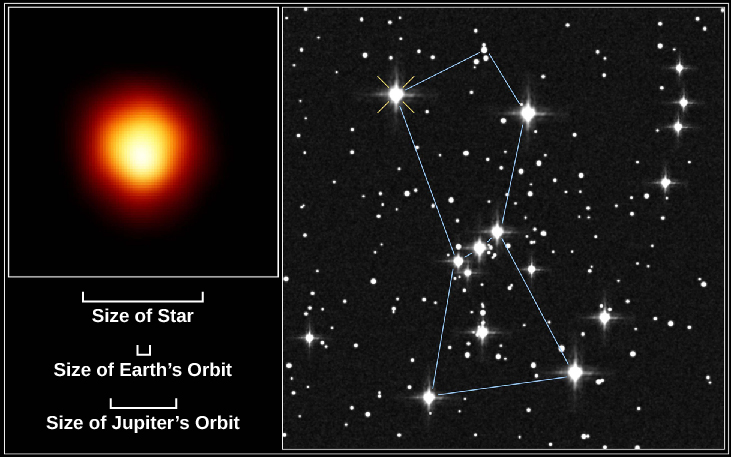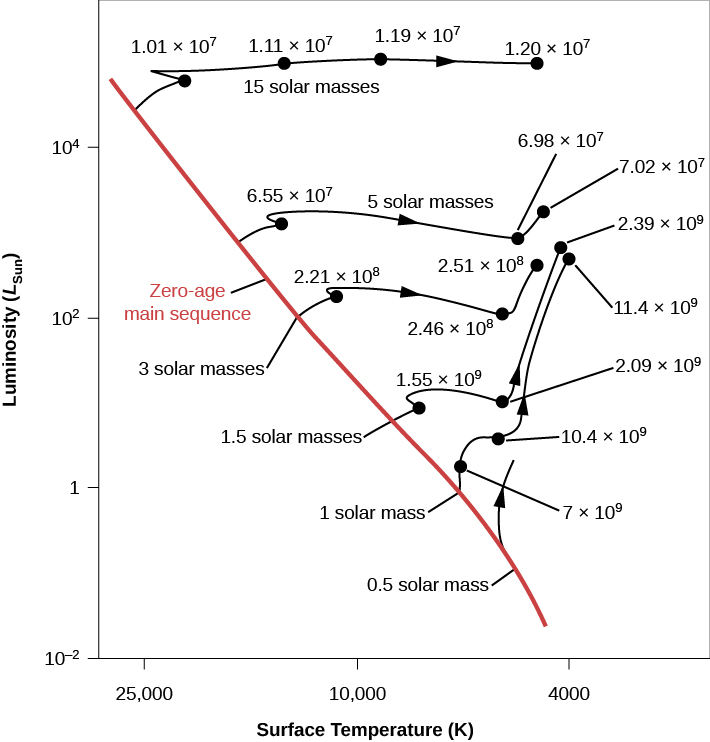| << Chapter < Page | Chapter >> Page > |
So the star becomes simultaneously more luminous and cooler. On the H–R diagram, the star therefore leaves the main-sequence band and moves upward (brighter) and to the right (cooler surface temperature). Over time, massive stars become red supergiants, and lower-mass stars like the Sun become red giants. (We first discussed such giant stars in The Stars: A Celestial Census ; here we see how such “swollen” stars originate.) You might also say that these stars have “split personalities”: their cores are contracting while their outer layers are expanding. (Note that red giant stars do not actually look deep red; their colors are more like orange or orange-red.)
Just how different are these red giants and supergiants from a main-sequence star? [link] compares the Sun with the red supergiant Betelgeuse , which is visible above Orion’s belt as the bright red star that marks the hunter’s armpit. Relative to the Sun, this supergiant has a much larger radius, a much lower average density, a cooler surface, and a much hotter core.
| Comparing a Supergiant with the Sun | ||
|---|---|---|
| Property | Sun | Betelgeuse |
| Mass (2 × 10 33 g) | 1 | 16 |
| Radius (km) | 700,000 | 500,000,000 |
| Surface temperature (K) | 5,800 | 3,600 |
| Core temperature (K) | 15,000,000 | 160,000,000 |
| Luminosity (4 × 10 26 W) | 1 | 46,000 |
| Average density (g/cm 3 ) | 1.4 | 1.3 × 10 –7 |
| Age (millions of years) | 4,500 | 10 |
Red giants can become so large that if we were to replace the Sun with one of them, its outer atmosphere would extend to the orbit of Mars or even beyond ( [link] ). This is the next stage in the life of a star as it moves (to continue our analogy to human lives) from its long period of “youth” and “adulthood” to “old age.” (After all, many human beings today also see their outer layers expand a bit as they get older.) By considering the relative ages of the Sun and Betelgeuse, we can also see that the idea that “bigger stars die faster” is indeed true here. Betelgeuse is a mere 10 million years old, which is relatively young compared with our Sun’s 4.5 billion years, but it is already nearing its death throes as a red supergiant.

As we discussed earlier, astronomers can construct computer models of stars with different masses and compositions to see how stars change throughout their lives. [link] , which is based on theoretical calculations by University of Illinois astronomer Icko Iben, shows an H–R diagram with several tracks of evolution from the main sequence to the giant stage. Tracks are shown for stars with different masses (from 0.5 to 15 times the mass of our Sun) and with chemical compositions similar to that of the Sun. The red line is the initial or zero-age main sequence. The numbers along the tracks indicate the time, in years, required for each star to reach those points in their evolution after leaving the main sequence. Once again, you can see that the more massive a star is, the more quickly it goes through each stage in its life.

Note that the most massive star in this diagram has a mass similar to that of Betelgeuse , and so its evolutionary track shows approximately the history of Betelgeuse. The track for a 1-solar-mass star shows that the Sun is still in the main-sequence phase of evolution, since it is only about 4.5 billion years old. It will be billions of years before the Sun begins its own “climb” away from the main sequence—the expansion of its outer layers that will make it a red giant.
When stars first begin to fuse hydrogen to helium, they lie on the zero-age main sequence. The amount of time a star spends in the main-sequence stage depends on its mass. More massive stars complete each stage of evolution more quickly than lower-mass stars. The fusion of hydrogen to form helium changes the interior composition of a star, which in turn results in changes in its temperature, luminosity, and radius. Eventually, as stars age, they evolve away from the main sequence to become red giants or supergiants. The core of a red giant is contracting, but the outer layers are expanding as a result of hydrogen fusion in a shell outside the core. The star gets larger, redder, and more luminous as it expands and cools.

Notification Switch
Would you like to follow the 'Astronomy' conversation and receive update notifications?